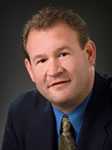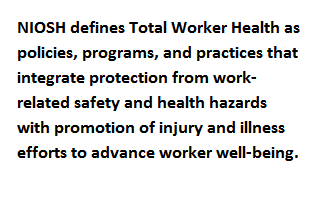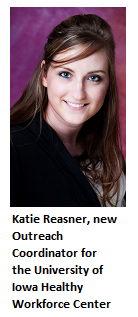TWH™ in Action!
Volume 4 Number 3 November 2015

In this issue:
- Managers’ Buzz
- Total Worker Health Exclusive
- Updates from the NIOSH Office for Total Worker Health
- Promising Practices for Total Worker Health
- Updates from NIOSH Centers of Excellence for Total Worker Health
- News from NIOSH Total Worker Health Affiliates and Partners
- New Publications and Resources
- Conferences, Webinars, and Trainings in Support of Total Worker Health
- Contributors
Managers’ Buzz
Anita L Schill, PhD, MA, MPH, and L Casey Chosewood, MD, MPH
In most places across our country, autumn heralds a colorful, vibrant season of change. This issue of TWH in Action! is chock full of news about change. Since our last edition of e-News, we’ve been busy charting new horizons for Total Worker Health®.
We’re happy to report that “Total Worker Health” is now a registered trademark of the U.S. Department of Health and Human Services. Our successful trademark registration is a testament to your tremendous support of Total Worker Health (TWH) over the past five years. It also recognizes the innovative nature of TWH and the resonance it has with a wide variety of stakeholders and audiences. Clear recognition of TWH as a unique approach helps us advance more impactful worker protection practices, programs, and policies and continues—with your help—to improve the well-being of our nation’s workers.
 Remember the programmatic evolution we mentioned in our last issue of the newsletter? We are now delighted to share a revised, expanded definition of Total Worker Health, which we believe more accurately reflects the unique contribution of TWH for tackling issues facing today’s workers and employers. The goal of this evolved TWH approach is to more accurately focus on the importance of safeguarding workers and expanding the number of ways that safer, healthier work advances worker well-being. Read more about our expanded program emphasis areas in this Total Worker Health Exclusive.
Remember the programmatic evolution we mentioned in our last issue of the newsletter? We are now delighted to share a revised, expanded definition of Total Worker Health, which we believe more accurately reflects the unique contribution of TWH for tackling issues facing today’s workers and employers. The goal of this evolved TWH approach is to more accurately focus on the importance of safeguarding workers and expanding the number of ways that safer, healthier work advances worker well-being. Read more about our expanded program emphasis areas in this Total Worker Health Exclusive.
We are pleased to report the launch of the National Center for Productive Aging and Work. The TWH-branded, virtual Center will advance the concept of productive aging—providing a safe and healthful work environment for all workers, and creating conditions that allow workers to function optimally and thrive from their first day on any job until they leave the workforce. To learn more about the exciting work of the new Center, please see Updates from the NIOSH Office for TWH.

For our current and potential academic research partners, please review our recently released Funding Opportunity Announcement (FOA) for the NIOSH Centers of Excellence for Total Worker Health®. The FOA will lead to the funding of vital TWH research and help us uncover new and exciting ways to advance the science of TWH. We look forward to collaborating with our Centers of Excellence in the years ahead.
Thank you for all you do each and every day to advance Total Worker Health in your own organizations and workplaces. We hope this newsletter inspires you to continue your work as a dedicated advocate. Share your comments and stories about TWH in Action! on Twitter (@NIOSH_TWH), on the NIOSH Total Worker Health LinkedIn Group, or by email at twh@cdc.gov.
Total Worker Health Exclusive
Modern Perspectives on Total Worker Health
As the primary federal agency that conducts research and makes recommendations to prevent worker injury and illness, NIOSH is continuously innovating in response to the latest science and practice, emerging workplace risks and hazards, input from stakeholders, and direction from NIOSH scientists and leaders. Accordingly, the NIOSH Total Worker Health Program is shifting to further emphasize and clarify what is Total Worker Health. In July 2015, NIOSH revised its definition of “Total Worker Health” as policies, programs, and practices that integrate protection from work-related safety and health hazards with promotion of injury and illness prevention efforts to advance worker well-being. Simply put, the TWH approach integrates workplace interventions that protect workers’ safety and health with activities that advance their overall well-being.

Pertinent to the 21st century workplace with workers and employers facing fierce economic pressures in a global marketplace, emerging forms of employment, new technologies, an increasingly older workforce, and the narrowing line between work and home life, Total Worker Health recognizes the linkages between health conditions that may not arise from work but that can be adversely affected by work. Total Worker Health also recognizes that as companies continue to confront the legacy hazards of the traditional workplace, such as traumatic injury and chemical exposures, the changing nature of work creates new opportunities for research and practice that seeks to understand the relationships to illness and injury. Total Worker Health advocates for integration of all organizational policies, programs and practices that contribute to worker safety, health and well-being, including those relevant to the control of hazards and exposures, the organization of work, compensation and benefits, built environment supports, leadership, changing workforce demographics, policy issues, and community supports. For a revised list issues that are relevant to advancing worker well-being through a Total Worker Health approach, please visit /niosh/twh/totalhealth.html.
Just as important as it is to describe what Total Worker Health is, it is equally important to describe what TWH is not. TWH is not a “wellness program” that has been implemented without simultaneously providing safe and healthful working conditions. TWH is not a collection of health promotion efforts implemented in a workplace where the work organization and structure contribute to worker injuries and illnesses. Workplace policies that discriminate against or penalize workers on the basis of health conditions or inadvertently create disincentives for improving health are not consistent with a TWH approach.
Keeping workers safe is the foundation upon which a TWH approach is built. Employers and employer-worker partnerships wishing to sustain and improve worker health must make occupational safety and health the priority—the foundation for all other health improvements. The TWH team at NIOSH will continue to work closely with partners and stakeholders to deliver evidence-based information to tailor workplace solutions with a TWH approach. To learn more about Total Worker Health, including examples of integrated workplace interventions that protect workers’ safety and health with activities that advance their overall well-being, please visit the Frequently Asked Questions page.
Updates from the NIOSH Office for Total Worker Health
NIOSH Launches the National Center for Productive Aging and Work
The National Center for Productive Aging and Work, hosted by the NIOSH Office for Total Worker Health, will focus on safety for workers of all ages,

promote their lifelong well-being, and advance the concept of productive aging. In the context of work, productive aging involves providing a safe and healthy work environment for everyone through comprehensive strategies that allow workers to function optimally at all ages. The timing of the Center’s formation is more relevant today than ever before. By 2020, one in four American workers will be over the age of 55 (U.S. Bureau of Labor Statistics). The mission of the Center is to develop a research plan for improving the safety and health of workers of all ages, facilitate collaboration among researchers and partners, develop new interventions, and highlight best practices for creating “aging-friendly” workplaces. To explore research and educational opportunities or to help NIOSH identify and develop materials to serve an age-diverse workforce, please contact the co-directors, Dr. Jim Grosch and Dr. Juliann Scholl at NCPAW@cdc.gov.
NIH Workshop, “What’s Work Got to Do With It?” 12/9/15–12/10/15
NIOSH Total Worker Health is partnering with the National Institutes of Health Office of Disease Prevention and the National Heart, Lung, and Blood Institute to sponsor a free Pathways to Prevention (P2P) workshop examining Total Worker Health. “What’s Work Got to Do With It?” will be held December 9-10, 2015, in Bethesda, MD. The goal of the P2P workshop is to identify research gaps, identify methodological and scientific weaknesses, suggest research needs, and move the field forward through an unbiased, evidence-based assessment. Expert speakers will address workshop questions, and encourage open dialogue with panelists and attendees. Immediately following the workshop, an independent panel will prepare a summary and identify future research priorities. The free workshop is open to the public and will include a webcast. Please visit the workshop webpage for information, including the draft agenda and the videocast link. For more information including registration and continuing education opportunities, please visit the NIH P2P website.
Promising Practices for Total Worker Health
In this section of each issue we share with you examples of how employers from across the country and from a wide range of industries are taking steps to integrate workplace policies, programs, and practices that protect workers’ safety and health and advance their overall well-being. If your organization is proactively exploring opportunities to accomplish these goals by targeting the conditions of work to improve the health of your workforce, please email us at twh@cdc.gov.
Disclaimer: The mention of organizations and commercial entities and products in this article is for illustrative purposes only and does not represent an endorsement by NIOSH, the Centers for Disease Control and Prevention, or the U.S. Department of Health and Human Services.
Small Businesses, Big Impact: The Nebraska Safety Council/WorkWell (NeSC)
Reid Anderegg
Healthy Environments in Workplaces and Communities: The NeSC, a not-for-profit 501(c)(3) organization, has operated in Lincoln, NE, since 1961. Serving all of Nebraska, NeSC seeks to, “provide leadership and resources to promote a safe and healthy environment in our workplace and community.” With over 600 member organizations from more than 20 industries, including manufacturing, state and local governments, and construction, NeSC offers trainings, educational materials, and interactive consultations for its members. Unique to NeSC is its community focus which brings initiatives like safe driving programs to member organizations as well as community members. NeSC also offers integrated resources through the WorkWell division organizations to help employees achieve optimal well-being. Nebraska Department of Health and Human Services (NDHHS) maintains a strong partnership with NeSC, and together each year they plan how to best use funding to meet the needs of member businesses and the surrounding communities. Such collaboration allows both NeSC and NDHHS to achieve goals and objectives set forth by NIOSH, CDC, and OSHA. NeSC’s pursuit of safe and healthy environments in workplaces and communities led them to achieve TWH Affiliate status this year.
Targeted Approaches for Small Business: With around 35% of its membership represented by small enterprises, NeSC seeks creative ways to meet the needs of their members. In 2014, The University of Iowa Healthier Workforce Center for Excellence, a NIOSH TWH-funded Center, awarded NeSC a community pilot grant. NeSC then offered hands-on resources to participating small businesses in the community via the pilot grant program. It focused on implementation of TWH interventions at three small Nebraska businesses in the cities of Lincoln and Beatrice: Lincoln Airport Authority (77 workers), Distribution Inc. (23 workers), and DK Contracting (21 workers). These three were selected based on previous interactions with leadership and their interest in TWH solutions.
NeSC’s targeted methods reflect four guiding goals for building TWH infrastructure:
- Seek to understand
- Build the Roadmap
- Implement
- Evaluate and communicate.
NeSC created customized solutions such as providing interactive training and consultations, assisting with policy development and communication, offering training modules, and providing practical support. Each of the businesses was already meeting state and federal guidelines for workplace safety, but sought assistance from NeSC to expand safety beyond regulatory requirements with a TWH approach. The businesses could begin thinking about safety not just from a regulatory stance but also from a proactive and preventive level for their workers.
Lincoln Airport Authority, with guidance from NeSC, held leadership discussions, a key influencer focus group, and a strengths/ weaknesses/opportunities/ threats (SWOT) analysis. The small, municipal airport developed a mission statement and a worker-led committee to guide organizational decision-making around TWH. Distribution Inc. focused on specific initiatives related to vending machines, sleep health, and tobacco cessation, for instance. DK Contracting systematically gathered worker feedback for the first time, to determine how to create a customized TWH approach at its workplace. As a result, workers selected health assessments, blood profiles, and health coaching as the first steps in creating a TWH-focused organization. These specialized offerings for each participating small business demonstrate the flexibility that a Total Worker Health approach can take to meet the needs of your business.
Meet Businesses “Where They Are”: The Nebraska Safety Council/WorkWell experiences emphasize the importance of interaction between leadership and workers in establishing TWH programs, policies, and practices in small businesses. NeSC focuses on what each business is already doing to keep its workers safe, healthy, and well. This allows critical next steps to build upon the foundation already present at the business. By meeting the businesses “where they were” with safety, health, and well-being, NeSC developed infrastructure and allowed workers to lead changes, enabling the participating businesses to create sustainable impact. Leveraging partnerships, as NeSC did with the University of Iowa Healthier Workforce Center for Excellence, is another way to introduce TWH concepts into an organization.
Updates from NIOSH Centers for Excellence for Total Worker Health
The Center for the Promotion of Health in the New England Workplace (CPH-NEW)
CPH-NEW and colleagues at the University of Massachusetts Medical School have been awarded a $500,000 two-year grant to measure the effectiveness of a new Massachusetts state-wide worksite wellness training program. Working on Wellness will help small and medium-sized businesses target health and safety changes for employees and the workplace.“We are excited to be part of this program focused on TWH goals, combining occupational safety and health promotion,” says Punnett. CPH-NEW will evaluate program costs, activities, employee participation and business and health impacts.Health Resources in ActionandAdvancingWellness will deliver the program, beginning in Fall 2015.
The Center also just closed its application period for Letters of Intent for 2016 Pilot Grants. Through this program, the Center awards grants of up to $11,000 to researchers for projects related to TWH.
CPH-NEW recently released two articles as part of its CPH News & Views series, a semi-monthly column on emerging topics related to healthy workplaces:
- Alternative Computer Input Devices: Implications for Musculoskeletal Symptoms
- Musculoskeletal Pain and Exercise Self-Efficacy as Contributors to Low Level of Physical Activity and Quality of Life
Harvard T.H. Chan School of Public Health Center for Work, Health and Well-being
The Harvard T.H. Chan School of Public Health Center for Work, Health and Well-being was a co-sponsor and steering committee member of an October 2015 strategic planning conference to improve the health and safety of commercial fishermen and their families. Fishing has the highest occupational fatality rate in the country, and those working in the industry have high suicide and illness rates. They are also likely to be uninsured because their work is often sporadic work and through multiple employers. The three-day event brought together 64 experts from various sectors with longstanding interests in the well-being of fishing communities in the Northeast. The aim was to develop a common vision for the future and an action plan to achieve it.
The Center will present results from its dissemination project at the November 2015 American Public Health Association meeting in Chicago, focusing on the implementation of Total Worker Health approaches in smaller organizations delivered by HealthPartners, Inc., a current research collaborator. Presenters will then discuss the Center’s work in Total Worker Health at the December meeting of the New England chapter of the American College of Occupational and Environmental Medicine.

University of Iowa Healthier Workforce Center for Excellence (HWCE)
The University of Iowa’s Healthier Workforce Center for Excellence (HWCE) is pleased to announce Katie Reasner as its new Outreach Coordinator. With over a decade of outreach and education in public health and a passion for Total Worker Health, Katie is excited to join the team. Prior to working at HWCE, Katie provided sexual health education and outreach to schools in and around the Iowa City area as part of the United Action for Youth Health Education Program. There she was recognized for increasing outreach efforts and school partnerships. Katie holds a Bachelor’s degree in Communication from the University of Iowa and a Master of Public Health degree from the University of Iowa College of Public Health.
Dr. Diane Rohlman, Director of the University of Iowa HWCE, presented on Total Worker Health at the 2015 ‘Hawkeye on Safety’ Safety & Health Conference, in Coralville, Iowa, on October 1. She also traveled to St. Louis, Missouri, to present “Total Worker Health and You–Integration into Everyday Business Practices” at the 2nd Annual Employee Wellness Summit 2015 (October 14-15).
Oregon Healthy Workforce Center(OHWC)
Oregon Healthy Workforce Center continues its outreach and education efforts through the Health Impacts Safety series. These popular guides are now being made available in Spanish. OHWC Associate Director Leslie Hammer travelled to Halifax, Nova Scotia, to present “Interventions to Reduce Work-Life Stress and Improve Health of Workers” at the Annual Occupational Health and Psychology Summer Institute. Dr. Hammer has also recently partnered with the United States Forest Service to conduct a needs assessment of the USFS workforce, using a Total Worker Health integrated approach for health, safety, and well-being.
Dr. Ryan Olson, OHWC Principal Investigator, has exciting news: the COMPASS program was adapted for dissemination in the training system of the Oregon Home Care Commission.An evaluation with five test groups in the training system showed that the adapted program was a success, with potential to ultimately reach 60% of Oregon’s home care workers. COMPASS’ one-year post-intervention assessment is near completion, as is a qualitative study of its program participants.
In September, Dede Montgomery, Senior Research Associate and Outreach and Education lead, hosted a booth and presented on Total Worker Health at the Central Oregon Occupational Safety and Health Conference, in Bend, Oregon, and at the 2015 annual meeting of the Northwest Association of Occupational and Environmental Medicine, in Skamania, Washington.
News from NIOSH Total Worker Health Affiliates and Partners
The University of Michigan’s Health Management Research Center (HMRC) recently developed an e-book, “Why a Culture of Health Matters.” The material is based on a webinar hosted by HMRC and discusses the importance of an organizational strategy that supports worker health by recognizing “employees as the organization’s most valuable asset.” http://www.hmrc.umich.edu/research-education/webinars-ebooks
The International Brotherhood of Boilermakers, Iron Ship Builders, Blacksmiths, Forgers, and Helpers (IBB) is developing the Boilermaker Total Health (BtH) initiative to protect and improve members’ long-term health, well-being, and quality of life, both on and off the job. Worklife conditions for IBB members are challenging: contractual work, extended periods away from home, long hours, physical labor, and exposure to musculoskeletal, chemical, and other hazards. Through BtH, IBB will provide education, training, and member and family assistance to promote member health 24/7. The goal is also to develop benchmarks for functional abilities and medical assessment for pre-apprentices entering the trade.
New Publications and Resources
Using Total Worker Health concepts to Enhance Workplace Tobacco Prevention and Control
NIOSH has released a new Workplace Solutions document that discusses the importance of a Total Worker Health approach for workplace tobacco prevention and control programs and provides practical suggestions for employers and others who are responsible for worker safety and health.
“Protéjase en el trabajo”: Protect Yourself at Work
NIOSH has a new set of multimedia tools to help organizations that serve Spanish-speaking immigrant workers raise awareness about occupational safety and health. The tools also will help motivate workers to take action to prevent risks and improve workplace safety and health. Four booklets/brochures, two posters, and five real-worker testimonial videos—all in Spanish—can be viewed and downloaded free at English Protéjase website and Spanish Protéjase website. The theme of these materials is La Salud No Tiene Precio—Health Has No Price—and all materials in the series have gone through extensive testing with the intended audience. The materials provide evidence-based information to raise awareness about potential occupational safety and health issues and to encourage workers to seek assistance for any related questions or concerns.
Reducing Risks to Women Linked to Shift Work, Long Work Hours, and Related Workplace Sleep and Fatigue Issues
Claire Caruso, PhD, RN, FAAN of NIOSH recently released a new article in the September 2015 issue of the Journal of Women’s Health discussing the impacts of shift and long work hours on health and safety risks, particularly for women workers.
6 New Publications from Centers of Excellence for Total Worker Health
Total Worker Health Intervention Increases Activity of Sedentary Workers
In this randomized control trial from the University of Iowa Healthier Workforce Center for Excellence, investigators compared two intervention approaches to reduce sedentary behavior and improve health outcomes and productivity. Overweight/obese adults were put into: health protection only and integrated health protection/health promotion. Investigators found that the integrated-intervention group members significantly increased their occupational physical activity. Integrated-intervention recipients also saw improvements to certain key markers of physical health and productivity.
Validation of a New Metric for Assessing Approaches Integrating Health Protection and Health Promotion
Investigators at the Harvard T. H. Chan School of Public Health Center for Work, Health, and Well-Being published a study validating their tool for assessing organizational actions and policies to protect and promote worker safety and health. The overall score was positively associated with outcome measures of activities and policies for health protection and promotion, supporting the tool’s reliability. This new measure might be useful to professionals interested in assessing TWH approaches and planning future actions within their organizations. The tool may also be of interest to researchers seeking to define and measure TWH approaches.
Length of Time Spent Working on a Commercial Construction Site and the Associations with Worker Characteristics
Another study led by the Harvard T. H. Chan School of Public Health Center for Work, Health and Well-being found that approximately 56% of construction workers stayed on a given worksite for at least one month, which has implications for design and implementation of worksite-based intervention studies in construction. This length of stay was significantly associated with workers’ race/ethnicity, union status, title, trade, and musculoskeletal pain status. Workers who reported musculoskeletalpain had over two times the odds of being short-term (less than one month) versus long-term (greater than one month) on a site, when adjustments were made for trade, title, and race/ethnicity.
Obesity/Overweight and the Role of Working Conditions: A Qualitative, Participatory Investigation
Researchers at The Center for the Promotion of Health in the New England (CPH-NEW) reported on a new study in the September issue of Health Promotion Practice, chronicling the impact of working conditions on health and weight for lower-income workers. Worker interviews highlighted four themes they cited as contributing to their health and weight: physically demanding work, psychosocial work stressors, the food environment at work, and time pressures related to both work scheduling and responsibilities outside of work.
The Productivity Dilemma in Workplace Health Promotion
CPH-NEW published a review in The Scientific World Journal exploring and comparing study findings related to the economics and return on investment of worksite-based programs to improve workforce health and well-being.
Considering the Differential Impact of Three Facets of Organizational Health Climate on Employees’ Well-Being
In a recent issue of The Scientific World Journal, researchers at CPH-NEW examined “health climate” at the workgroup, supervisor, and organization- level, concluding that strength in each of these three areas is most beneficial for driving employee well-being at work.
RWJF Brief: Nursing’s role in helping employers build safe, healthy workplaces
The September 2015 edition of Charting Nursing’s Future, produced by the Robert Wood Johnson Foundation focuses on the role that nurses play in building a culture of health in the workplace. The brief highlights the relevance of the Total Worker Health approach to occupational health nursing and of NIOSH’s research and training related to the impacts of shift work.
Conferences, Webinars, and Trainings in Support of NIOSH Total Worker Health
Upcoming Speaking Engagements
November
5: At theIowa Governor’s Safety and Health Conference in Alabama, Dr. Chosewood will give a keynote address on “Total Worker Health: Strategies for Safer Work and Healthier Workplaces”.
12: At the 17th Annual Pennsylvania Drilling and Blasting Conference, Dr. Chosewood will present a plenary session entitled “Total Worker Health—The Next Frontier for Improved Safety, Health, and Performance”.
17–18: Jennifer Cavallari of CPH-NEW, will present “Designing Healthy Workplaces: The CPH-NEW Healthy Workplace Participatory Program,” at the ASSENew England Chapters Conference: Learning from Each Other, in Falmouth, MA.
December
8: At the 25th Annual California Industrial Hygiene Council Conference, in San Francisco, CA,Dr. Chosewood will present a plenary presentation on “NIOSH Total Worker Health:Solutions for Greater Worker Safety and Workplace Health”.
NIOSH Total Worker Health® Webinar Series
Save the date! On January 19, the NIOSH Total Worker Health Webinar Series will feature an expert panel of speakers that will discuss the impact of work-related stress on families, research findings and policy trends related to work-family support for low-income families, and practical employer approaches aimed to improve the safety, health and well-being of workers. Look for more details to come on the NIOSH TWH Webinar Series page.
CPH-NEW Healthy Workplace Webinar Training Series
The CPH-NEW Healthy Workplace Participatory Program has new free training webinars available on demand. These 50-minute webinars show how to get managers to support programs that boost workplace health, safety, and well-being. The most recent webinar is “Making the Pitch: Introducing the Healthy Workplace Participatory Program for Total Worker Health.” Contact cphnew@uml.edu to request training and support for implementing the Healthy Workplace Participatory Program.
Mindfulness and Total Worker Health
The Oregon Healthy Workforce Center, along with the Oregon Institute of Occupational Health Sciences, Portland State University, and SAIF Corporation will present a Fall Symposium on Mindfulness andTotal Worker Healthon November 20, 2015. Registration is open, and the event will include a live webinar available on the OHWC website.
Work, Health, and Well-Being: Integrating Wellness and Occupational Health and Safety in the Workplace
The Harvard T. H. Chan School of Public Health’s Center for Work, Health and Well-being will be hosting its annual Executive Continuing and Professional Education Course, on Work, Health, and Well-Being: Integrating Wellness and Occupational Health and Safety in the Workplace, on February 1–3, 2016 in Boston, MA. Students learn to use policies, programs, and practices into a comprehensive program that enhances the overall health and well-being of the workforce and reduce work-related injuries and illnesses. This program teaches skills needed for:
- Evaluating worksite and worker health risks
- Translating occupational health and safety research into practice
- Measuring outcomes and evaluating health and safety programs
- Assessing the financial impact of workplace health programs
Contributors
Editorial Board
L. Casey Chosewood, MD, MPH, Executive Editor
Anita L. Schill, PhD, MA, MPH, Executive Editor
CDR Heidi Hudson, MPH, Managing Editor
Michelle Lee, Associate Editor
Reid Anderegg, Associate Editor
Seleen Collins, Copy Editor
Steve Leonard, NIOSH Web Publisher
Please send your comments and suggestions to us at twh@cdc.gov
This newsletter is published quarterly via email by the National Institute for Occupational Safety and Health Total Worker Health® Program to inform members of the public health community as well as interested members of the general public of program-related news, new publications, and updates on existing activities and initiatives.
Get Email Updates
To sign up to receive the TWH Newsletter, enter your email address:
- Page last reviewed: November 4, 2015
- Page last updated: November 6, 2015
- Content source:
- National Institute for Occupational Safety and Health Office of the Director
TOTAL WORKER HEALTH ® is a registered trademark of the US Department of Health and Human Services


 ShareCompartir
ShareCompartir